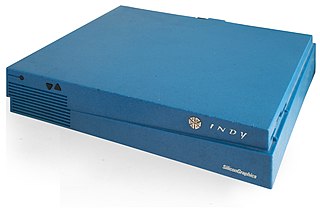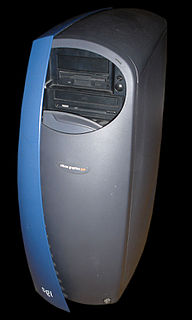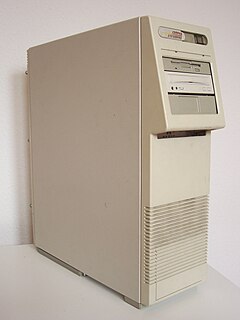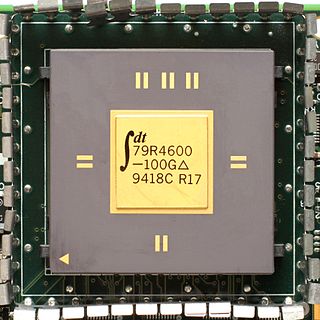Characteristics
The NiTro-VLB is notable for various unique characteristics among personal computer accessories. For example, although the system was marketed as an "upgrade" for computers already using a 486 processor, the NiTro-VLB was in fact of an entirely different architecture (specifically, the MIPS architecture) from the IA32-based 486. Further, as a "parasitic" or "symbiotic" coprocessor, the NiTro-VLB was designed to co-opt the host 486 processor from running, and used four megabytes of the host 486 motherboard's system memory as a DMA buffer (although the NiTro-VLB required its own separate DRAM main memory, in addition to any memory installed on the host 486 motherboard).
MIPS is a reduced instruction set computer (RISC) instruction set architecture (ISA) developed by MIPS Computer Systems.

A coprocessor is a computer processor used to supplement the functions of the primary processor. Operations performed by the coprocessor may be floating point arithmetic, graphics, signal processing, string processing, cryptography or I/O interfacing with peripheral devices. By offloading processor-intensive tasks from the main processor, coprocessors can accelerate system performance. Coprocessors allow a line of computers to be customized, so that customers who do not need the extra performance do not need to pay for it.
Direct memory access (DMA) is a feature of computer systems that allows certain hardware subsystems to access main system memory, independent of the central processing unit (CPU).
This is a type of "parasite"/"host" upgrade card configuration, in which an entire motherboard and processor are implemented on an expansion card designed to connect to a host motherboard's expansion slot. Such configurations are rare among computer systems designed to run Microsoft Windows.
Microsoft Windows is a group of several graphical operating system families, all of which are developed, marketed, and sold by Microsoft. Each family caters to a certain sector of the computing industry. Active Windows families include Windows NT and Windows Embedded; these may encompass subfamilies, e.g. Windows Embedded Compact or Windows Server. Defunct Windows families include Windows 9x, Windows Mobile and Windows Phone.

The Extended Industry Standard Architecture is a bus standard for IBM PC compatible computers. It was announced in September 1988 by a consortium of PC clone vendors as a counter to IBM's use of its proprietary Micro Channel architecture (MCA) in its PS/2 series.

The Intel 80486, also known as the i486 or 486, is a higher performance follow-up to the Intel 80386 microprocessor. The 80486 was introduced in 1989 and was the first tightly pipelined x86 design as well as the first x86 chip to use more than a million transistors, due to a large on-chip cache and an integrated floating-point unit. It represents a fourth generation of binary compatible CPUs since the original 8086 of 1978.

The VESA Local Bus was a short-lived expansion bus introduced during the i486 generation of x86 IBM compatible personal computers. Created by VESA the VESA Local Bus worked alongside the then dominant ISA bus to provide a standardized high-speed conduit intended primarily to accelerate video (graphics) operations. VLB provided a standardized "fast path" that add-in (video) card makers could tap for greatly accelerated memory-mapped I/O and DMA, while still using the familiar ISA bus to handle basic device duties such as interrupts and port-mapped I/O.
The Intel i860 was a RISC microprocessor design introduced by Intel in 1989. It was one of Intel's first attempts at an entirely new, high-end instruction set architecture since the failed Intel iAPX 432 from the 1980s. It was released with considerable fanfare, slightly obscuring the earlier Intel i960, which was successful in some niches of embedded systems, and which many considered to be a better design. The i860 never achieved commercial success and the project was terminated in the mid-1990s.

The Am5x86 processor is an x86-compatible CPU introduced in 1995 by AMD for use in 486-class computer systems. It was one of the fastest, and most universally compatible upgrade paths for users of 486 systems.

The Indy, code-named "Guinness", is a low-end workstation introduced on July 12, 1993. Developed and manufactured by Silicon Graphics Incorporated (SGI), it is the result of the company's attempt to obtain a share of the low-end computer-aided design (CAD), desktop publishing, and multimedia markets. It was discontinued on June 30, 1997 and support ended on December 31, 2011.
The MIPS Magnum was a line of computer workstations designed by MIPS Computer Systems, Inc. and based on the MIPS series of RISC microprocessors. The first Magnum was released in March, 1990, and production of various models continued until 1993 when SGI bought MIPS Technologies. SGI cancelled the MIPS Magnum line to promote their own workstations including the entry-level SGI Indy.
The NEC RISCstation was a line of computer workstations made by NEC in the mid-1990s, based on MIPS RISC microprocessors and designed to run Microsoft Windows NT. A series of nearly identical machines were also sold by NEC in headless configuration as the RISCserver series, and were intended for use as Windows NT workgroup servers.
The Jazz computer architecture was a motherboard and chipset design originally developed by Microsoft for use in developing Windows NT. The design was eventually used as the basis for most MIPS-based Windows NT systems.

SGI Visual Workstation is a series of workstation computers that are designed and manufactured by SGI. Unlike its other product lines, which used the 64-bit MIPS RISC architecture, the line used Intel Pentium II and III processors and shipped with Windows NT 4.0 or Windows 2000 as its operating system in lieu of IRIX. However, the Visual Workstation 320 and 540 models deviated from the architecture of IBM-compatible PCs by using SGI's ARCS firmware instead of a traditional BIOS, internal components adapted from its MIPS-based products, and other proprietary components that made them incompatible with internal hardware designed for standard PCs and hence unable to run other versions of Microsoft Windows, especially Windows 9x. By contrast, the remaining models in the line are standard PCs, using VIA Technologies chipsets, Nvidia video cards, and standard components.
DeskStation Technology was a manufacturer of RISC-based computer workstations intended to run Windows NT. DeskStation was based in Lenexa, Kansas.
ShaBLAMM! Computer was a startup computer company, founded in the early 1990s, which manufactured MIPS-based upgrade cards for systems running Windows NT.
The DeskStation Tyne was a line of computer workstations made by DeskStation Technology and based on the MIPS R4000 and R4400 RISC microprocessors. The DeskStation Tyne was designed to run Windows NT, and was designed to conform to the Advanced RISC Computing standard and run the associated firmware.

The R4000 is a microprocessor developed by MIPS Computer Systems that implements the MIPS III instruction set architecture (ISA). Officially announced on 1 October 1991, it was one of the first 64-bit microprocessors and the first MIPS III implementation. In the early 1990s, when RISC microprocessors were expected to replace CISC microprocessors such as the Intel i486, the R4000 was selected to be the microprocessor of the Advanced Computing Environment (ACE), an industry standard that intended to define a common RISC platform. ACE ultimately failed for a number of reasons, but the R4000 found success in the workstation and server markets.

The SystemPro from Compaq, released in November 1989, was arguably the first true PC based server. It supported Intel's 486 chip, a 32-bit bus, RAID disk and dual-processor support well before its main rivals.
The Digital Personal Workstation, code named "sports car", is a family of entry-level to mid-range workstation computers developed and manufactured by Digital Equipment Corporation (DEC). These workstations are based on the DEC Alpha and Intel Pentium Pro or Pentium II microprocessors. Members of this family can run the Digital UNIX, OpenVMS and Microsoft Windows NT operating systems.
The i-Series, based on Pentium Pro, was introduced first, on 23 September 1996.
The R4200 is a microprocessor designed by MIPS Technologies, Inc. (MTI) that implemented the MIPS III instruction set architecture (ISA). It was also known as the VRX during development. The microprocessor was licensed to NEC, and the company fabricated and marketed it as the VR4200. The first VR4200, an 80 MHz part, was introduced in 1993. A faster 100 MHz part became available in 1994. The R4200 was developed specifically for low-power Windows NT computers such as personal computers and laptops. MTI claimed the microprocessor's integer performance was greater than that of a high-end Intel i486 and 80% of a P5-variant Pentium microprocessor. The R4200 ultimately did not see any use in personal computers and was repositioned as an embedded microprocessor that competed with the R4600. The R4300i variant was used in the widely popular Nintendo 64 video game console.

The Cyrix Cx486 or Cyrix 486 was an x86-Compatible microprocessor designed by Cyrix to primarily compete with the Intel 486 with which it was software compatible, would operate in the same motherboards provided proper support by the BIOS was available and generally showed comparable performance. The chip also competed with parts from AMD and UMC.











